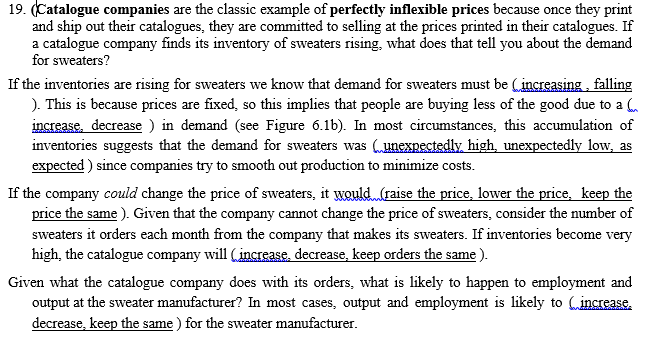and ship out their catalogues, they are committed to selling at the prices printed in their catalogues. If a catalogue company finds its inventory of sweaters rising, what does that tell you about the demand for sweaters? f the inventories are rising for sweaters we know that demand for sweaters must be (_increasing , falling ). This is because prices are fixed, so this implies that people are buying less of the good due to a C increase, decrease ) in demand (see Figure 6.1b). In most circumstances, this accumulation of inventories suggests that the demand for sweaters was (unexpectedly, high, unexpectedly low, as expected ) since companies try to smooth out production to minimize costs. f the company could change the price of sweaters, it would (raise the price, lower the price, keep the price the same ). Given that the company cannot change the price of sweaters, consider the number of sweaters it orders each month from the company that makes its sweaters. If inventories become very high, the catalogue company will (increase, decrease, keep orders the same ). Given what the catalogue company does with its orders, what is likely to happen to employment and output at the sweater manufacturer? In most cases, output and employment is likely to („increase.
and ship out their catalogues, they are committed to selling at the prices printed in their catalogues. If a catalogue company finds its inventory of sweaters rising, what does that tell you about the demand for sweaters? f the inventories are rising for sweaters we know that demand for sweaters must be (_increasing , falling ). This is because prices are fixed, so this implies that people are buying less of the good due to a C increase, decrease ) in demand (see Figure 6.1b). In most circumstances, this accumulation of inventories suggests that the demand for sweaters was (unexpectedly, high, unexpectedly low, as expected ) since companies try to smooth out production to minimize costs. f the company could change the price of sweaters, it would (raise the price, lower the price, keep the price the same ). Given that the company cannot change the price of sweaters, consider the number of sweaters it orders each month from the company that makes its sweaters. If inventories become very high, the catalogue company will (increase, decrease, keep orders the same ). Given what the catalogue company does with its orders, what is likely to happen to employment and output at the sweater manufacturer? In most cases, output and employment is likely to („increase.
Principles of Economics 2e
2nd Edition
ISBN:9781947172364
Author:Steven A. Greenlaw; David Shapiro
Publisher:Steven A. Greenlaw; David Shapiro
Chapter33: International Trade
Section: Chapter Questions
Problem 22CTQ: You just got a job in Washington, D.C. You move into an apartment with some acquaintances. All your...
Related questions
Question

Transcribed Image Text:19. (Catalogue companies are the classic example of perfectly inflexible prices because once they print
and ship out their catalogues, they are committed to selling at the prices printed in their catalogues. If
a catalogue company finds its inventory of sweaters rising, what does that tell you about the demand
for sweaters?
If the inventories are rising for sweaters we know that demand for sweaters must be increasing, falling
). This is because prices are fixed, so this implies that people are buying less of the good due to a .
increase, decrease ) in demand (see Figure 6.1b). In most circumstances, this accumulation of
inventories suggests that the demand for sweaters was unexpectedly, high, unexpectedly low, as
expected ) since companies try to smooth out production to minimize costs.
If the company could change the price of sweaters, it would (raise the price, lower the price, keep the
price the same ). Given that the company cannot change the price of sweaters, consider the number of
sweaters it orders each month from the company that makes its sweaters. If inventories become very
high, the catalogue company will (increase, decrease, keep orders the same ).
Given what the catalogue company does with its orders, what is likely to happen to employment and
output at the sweater manufacturer? In most cases, output and employment is likely to increase.
decrease, keep the same ) for the sweater manufacturer.
Expert Solution
This question has been solved!
Explore an expertly crafted, step-by-step solution for a thorough understanding of key concepts.
This is a popular solution!
Trending now
This is a popular solution!
Step by step
Solved in 2 steps

Recommended textbooks for you

Principles of Economics 2e
Economics
ISBN:
9781947172364
Author:
Steven A. Greenlaw; David Shapiro
Publisher:
OpenStax


Principles of Economics 2e
Economics
ISBN:
9781947172364
Author:
Steven A. Greenlaw; David Shapiro
Publisher:
OpenStax
